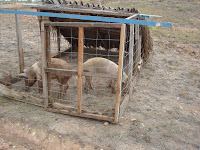


How to convert a dry/waterlogged, poor soil landscape into a lush rich garden!
Here we are starting a whole new project on converting poor soil, with hard tufts of grasses into useable agricultural soil. The soil is highly weathered clay, with non existing top soil, which becomes waterlooged and sticky during torrential rains, and dry packed hard soil during the dry season. The area is extremely dry with intermittent rainfall in the rainy season. This picture was taken at the end of the dry season.
The name Terra Preta is derived from the soil fenomenon found in the Amazon basin. These earths appear to be anthropogenic and have been studied in recent years, to find out why this soil, apparently created by ancient indian is so fertile and black even centuries later. We will be using some of those techniques in this system later on.
STEP 1.
Create an interconnected swale/water hole system.
Swales are constructed perpendicular to hills. These swales collect rainwater and carry it along at a 2% grade across the land. At each junction a water hole is constructed, from which another swale carries the overload across the land in the opposite directtion. Water holes can also be constructed in between junctions to allow collection of excess rain water.
Then end result is a zig-zag system of water channels which not only prevent erosion, but deposit the water in numerous water holes along the way before draining away into a nearby stream. The water is therfore maintained in these holes which allow moisture to seep into the surrounding soil between rainfall, or can be used for irrigation when necessary. This swale system will also be used for drainage later on.
STEP 2.
Put piggies to work! Pigs in piggy tractors, are put in place to excavate the soil little by little. If it is desired to do the work faste, one can use more pigs, in more tractors. The pigs are showered daily and the soil moistened, upon which they begin their work. The grasses are uprooted, and the end result is loose brown soil complete with pig manure!
No comments:
Post a Comment